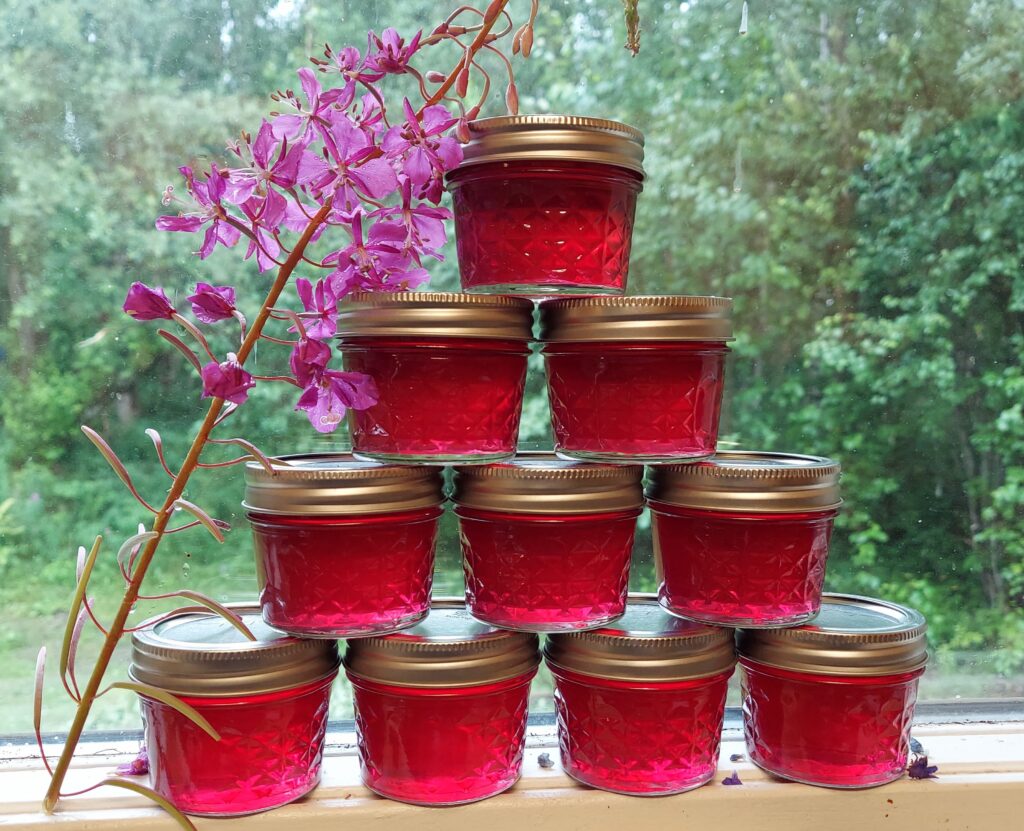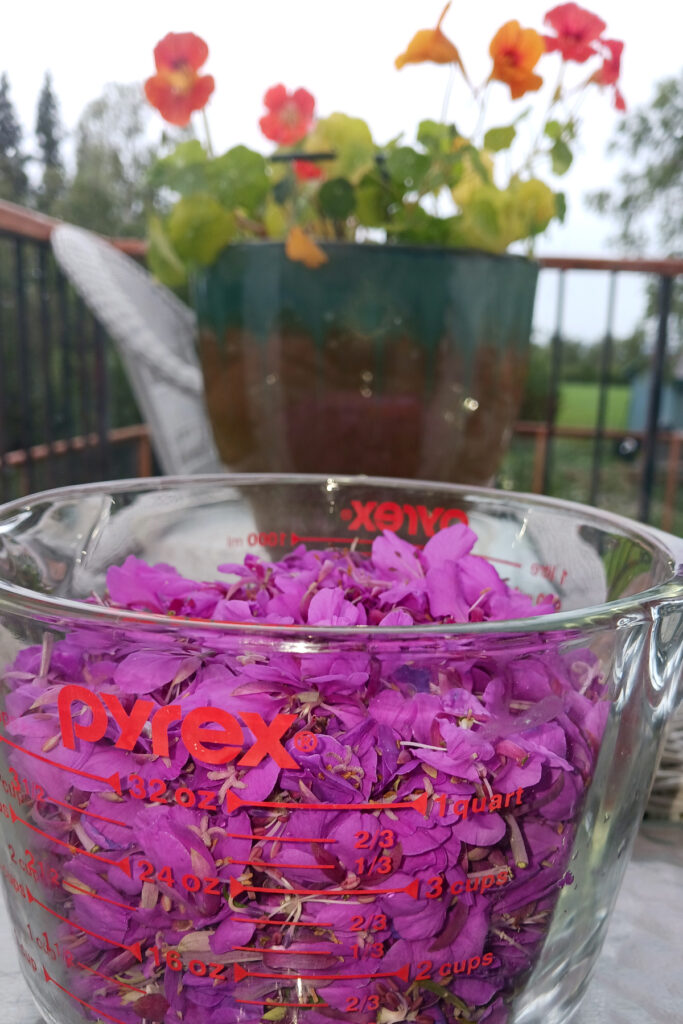Wild foods can have some of the best health benefits—and best tastes. Fireweed (Crassocephalum crepidioides) is one of them. So is horsetail that pretty much invades every garden. Do you enjoy foraging? Follow the links on this page or use the search function and the word “wild” to find other recipe ideas.
Traditionally, fireweed is used for pain and swelling (inflammation), migraines, fevers, tumors, wounds, and enlarged prostate (benign prostatic hyperplasia, BPH). It is also used as an astringent and as a tonic. Plus, 1 cup of fireweed leaves chopped = ~100mg of calcium (about 10% daily value) and very good source of manganese (78% daily value). Poltices made from fireweed are used to draw out mild wound infections.
Fireweed is a plant with fleshy, mucilaginous leaves and stems that are often eaten as a vegetable, added to salads raw or . The mucilage in fireweed can be tasted, and it has a slippery substance that can make your mouth feel smooth. The larger stalks of fireweed can be split and the inner pith eaten as a sweet treat, and it’s also high in mucilage and can be used as a thickener in soups and other dishes. The flowers make a pretty addition in salads or a garnish for other dishes—be visually creative.
Fireweed tea made from drying both the flowers and leaves then steeping them like other dried teas is also mucilagenous and a great way to sooth an upset tummy.
Important Note: Please hike up a trail somewhere… not far… you just don’t want roadside fireweed that collects road dust and other contaminants. Of course if you want to hike further, Devil’s Pass trail also known as Devil’s Creek trail is a spectacular valley with fireweed that grows taller the I am. I’ll let you find it hint: it’s before the Cooper Landing turn-off. Another hint: there are details at Alaska.org. Another place to find fireweed (named after its pyrophytic, or fire-adaptive, properties) is in past burns. Fireweed is often the first plant to emerge from the ashes of a forest fire.
Fireweed, (botanical name epilobium angustifolium) is in the evening primrose family. Author and wild plants expert Janice Schofield writes that there are up to 20 varieties of epilobium in Alaska. From dwarf fireweed found often near rivers to tall fireweed at the first part of the Devil’s Pass trail, if the variety near you is fading, just go higher up.
Why would I be recommending a jelly that most people will load up with cane sugar? Of course this defeats the healing potential, cane sugar being quite inflammatory. Jelly and jam makers argue that cane sugar is needed for the pectin to set up and give the jelly the right texture. I did our homework and learned of Pomona Pectin. It set’s up with calcium, rather than sugar, so can be used to make all manner of low/no sugar items. They have an abundance of recipes on their website (https://pomonapectin.com/category/recipes/)
For the fireweed jelly, I contacted Shelby Collings, customer support at Pomona, by email: info@pomonapectin.com. Shelby answered my questions same day, very helpful! She writes: “You can use maple syrup, raw honey or coconut sugar in any of our recipes! Coconut sugar will be cup for cup and the liquid sweeteners will measure at 50% of the called for amount of sugar.” What great guidance!! With that said, I began to adapt the Rose Petal jelly recipe here (https://pomonapectin.com/rose-petal-jelly-2/).
In Anchorage, Pomona Pectin is available at Alaska Mill and Feed. Pomona’s website also has a shopping cart and ships to anywhere in the US and I believe Canada.
Makes 1.5 Pints or 6 1/2 pints
3 cups Fireweed Juice (note, because I did not pack the fireweed flowers, although I used 4 cups each water and flowers, I let it simmer down to get the richness and color I wanted then adapted the recipe for that volume of juice—see Instructions)
2⅓ teaspoons calcium water see step #1—the calcium powder comes in the box with Pomona Pectin.
6 Tablespoons lemon juice bottled
1 cup plus 5 Tablespoons coconut sugar or ¾ cup maple syrup or raw honey
2⅔ teaspoons Pomona’s Pectin powder
3-4 pint canning jars or other sizes should you want to keep the jelly in smaller amounts.
Preparation
- Fireweed juice can be made in advance then stored in the fridge a few days until ready to prepare the jelly. It also freezes well if you are waiting for that rainy day. To make the juice: Collect your fireweed flowers and ideally pack them until you have the desired volume. Wash briefly then strain the washwater out, discard the washwater.
- Place the 3 cups of washed/strained fireweed flowers in a sauce pan with 3 ½ cups water (some will boil off). Bring to a boil. then reduce the heat to simmer at least 20 minutes until the flowers turn white and the juice is the color you’d like—may take longer that 20 minutes. Pour the fireweed juice through a strainer into a large measuring cup or bowl—this allows you to see how much volume you have.
-
Calcium water: Note, this makes far more calcium water than you actually need for this recipe—it stores well in the fridge if you want to try your hand at some of the other Pomona Pectin recipes. If unsure, scale it back.
-
To make the calcium water, combine ½ teaspoon calcium powder (in the small packet in your box of Pomona’s pectin) with ½ cup water in a small, clean jar with a lid. Shake well.
Calcium water should be stored in the refrigerator until ready for use, including future use. -
When ready to make the jelly: Wash jars, lids, and bands. Place jars in a canner or large soup pot. Fill canner 2/3 full with water, bring to a boil. Turn off heat, cover, and keep jars in hot canner water until ready to use. Place lids in water in a small sauce pan; cover and heat to a low boil. Turn off heat and keep lids in hot water until ready to use.
-
Measure sugar/honey/maple syrup into a bowl. Thoroughly mix pectin powder into sugar. Set aside.
- Bring fireweed juice to a full boil.
- Mix calcium water and lemon juice together and add to the hot fireweed juice.
-
Add pectin-sugar mixture, stirring vigorously for 1 to 2 minutes to dissolve the pectin while the jelly comes back up to a boil. Once the jelly returns to a full boil, remove it from the heat. (Note: you can use some fireweed juice to get ALL of the pectin mixture out of the bowl)
-
Fill hot jars to ¼ inches of top. Wipe rims clean. Screw on 2-piece lids. Put filled jars in boiling water to cover. Boil 10 minutes (add 1 minute more for every 1,000 ft. above sea level). Remove from water. Let jars cool. Check seals; lids should be sucked down. Shelf stable for 1 year. Lasts 3 weeks once opened.
There are many possible adaptations like mixing in wild rose petals, adding 2 small jalapenos (chopped), decorating the top of the jelly with additional fireweed flowers as it sets up (and before entirely set), add a small amount of cinnamon and allspice to taste, combine with any berries (don’t change the liquid volume)… get creative.
May the jelly be with you 😛









